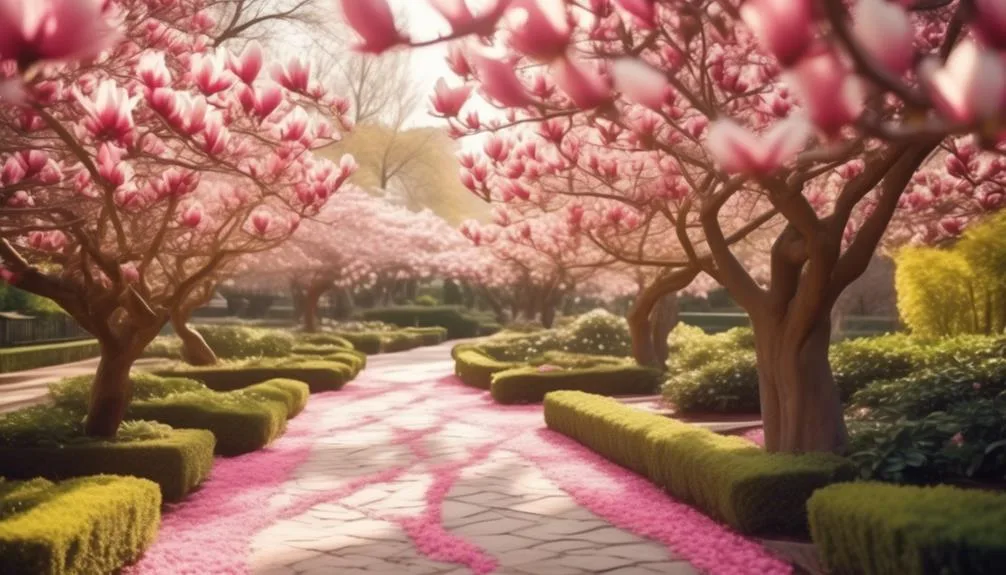If you enjoy the fragrance of magnolia blossoms, you'll be glad to know that there are many public gardens where you can see these beautiful trees.
From botanical gardens to public parks, you can find magnolia trees in various places.
But where are the best locations? Keep reading to find out where you can experience the timeless charm of magnolia trees and enjoy their stunning beauty.
Botanical Gardens
Curious about the diverse array of magnolia trees found in botanical gardens? Well, you're in for a treat!
Botanical gardens are a haven for a wide variety of magnolia species, showcasing their beauty and diversity. These gardens often host special events, like magnolia festivals or guided tours, where you can learn about different magnolia species and their unique characteristics.
You can witness the stunning blooms of early-blooming magnolias or marvel at the grandeur of large-flowered species. These garden events offer a fantastic opportunity to immerse yourself in the world of magnolias, gaining insight into their history, cultivation, and significance.
Public Parks
With their lush greenery and vibrant floral displays, public parks offer a delightful setting to admire the beauty of magnolia trees. When visiting these parks, keep an eye out for the distinctive features that aid in tree identification, such as the large, showy blossoms and glossy, dark green leaves of the magnolia tree.
Many public parks also host magnolia blossom festivals, where you can revel in the stunning array of colors and scents. These events often feature guided tours that provide insight into the different magnolia tree species and their unique characteristics. Additionally, some parks offer educational programs on magnolia tree care and cultivation.
Whether you're a nature enthusiast or simply appreciate a leisurely stroll through beautiful surroundings, public parks are an excellent place to discover and appreciate the magnificence of magnolia trees.
Arboretums
Arboretums showcase an impressive collection of magnolia trees, offering a diverse and captivating display of this beloved species. When visiting an arboretum, you can expect to find a wide variety of magnolia trees, each with its own unique characteristics and beauty. Here's what you can learn and experience in an arboretum:
- Tree identification: Arboretums are the perfect place to learn about different magnolia species, their distinct features, and how to identify them in the wild.
- Magnolia bloom times: You can observe the varying bloom times of different magnolia trees, gaining insight into the seasonal patterns and enjoying the stunning displays of colorful blossoms.
- Educational resources: Arboretums often provide educational materials and guided tours, offering valuable information about magnolia trees and their significance in horticulture and nature.
Arboretums aren't only beautiful but also educational, making them an ideal destination for magnolia enthusiasts.
Historical Estates
As you explore historical estates, you'll encounter grand magnolia trees that have stood the test of time, adding a touch of timeless elegance to these storied properties.
Many of these estates boast magnolia trees that predate the grand buildings themselves, their sprawling branches and fragrant blooms becoming intertwined with the cultural heritage of the area.
The architectural significance of these trees lies not only in their beauty but in the way they enhance the grandeur of the estate's design.
Preservation efforts are often in place to protect these living relics, ensuring that they continue to grace the landscape for generations to come.
Additionally, restoration projects frequently focus on maintaining and enhancing the presence of these magnificent magnolia trees, further solidifying their place as integral components of these historical estates.
Urban Green Spaces
Urban green spaces offer a welcome respite from the hustle and bustle of city life, providing a tranquil oasis for local residents and visitors alike. These spaces not only contribute to the aesthetic appeal of a city but also play a vital role in promoting environmental sustainability and community well-being.
When exploring urban green spaces, keep an eye out for the following:
- Community Gardens: These vibrant spaces foster a sense of community and provide opportunities for locals to grow their own produce, share gardening knowledge, and connect with nature in the heart of the city.
- Rooftop Gardens: Elevated above the urban landscape, rooftop gardens offer breathtaking views and a peaceful retreat for relaxation and contemplation.
- Urban Forests and City Greenways: These interconnected networks of green spaces provide essential habitats for wildlife, improve air quality, and offer recreational opportunities for urban dwellers.
Conclusion
In public gardens, whether urban or botanical, the serene beauty of magnolia trees awaits. Take a leisurely walk, capture their splendor, and immerse yourself in the natural charm they offer.
It's a delightful experience for anyone seeking solace in nature's embrace.

My interest in trees started when I first saw the giant sequoias in Yosemite.
I was a teenager then, and I remember thinking, “I need to learn more about this.”
That moment stuck with me.
A few years later, I went on to study forestry at Michigan Tech.
Since graduating, I’ve worked in a mix of hands-on tree care and community education.
I’ve spent over ten years helping people understand how to plant, maintain, and protect the trees in their neighborhoods.
I don’t see trees as just part of the landscape.
They are living things that make a real difference in our daily lives.
